Electrostatic Charging Tendency Analysis Concerning Retrofilling Power Transformers with Envirotemp FR3 Natural Ester
Abstract
1. Introduction
2. Materials and Methods
3. Results
4. Conclusions
Funding
Conflicts of Interest
References
- Wang, X.; Tang, C.; Huang, B.; Hao, J.; Chen, G. Review of research progress on the electrical properties and modification of mineral insulating oils used in power transformers. Energies 2018, 11, 487. [Google Scholar] [CrossRef]
- Fernández, I.; Ortiz, A.; Delgado, F.; Renedo, C.; Pérez, S. Comparative evaluation of alternative fluids for power transformers. Electr. Power Syst. Res. 2013, 98, 58–69. [Google Scholar] [CrossRef]
- Mohan Rao, U.; Fofana, I.; Jaya, T.; Rodriguez-Celis, E.M.; Jalbert, J.; Picher, P. Alternative dielectric fluids for transformer insulation system: Progress, challenges, and future prospects. IEEE Access 2019, 7, 184552–184571. [Google Scholar] [CrossRef]
- N’cho, J.S.; Fofana, I.; Hadjadj, Y.; Beroual, A. Review of physicochemical-based diagnostic techniques for assessing insulation condition in aged transformers. Energies 2016, 9, 367. [Google Scholar] [CrossRef]
- Mehta, D.M.; Kundu, P.; Chowdhury, A.; Lakhiani, V.K.; Jhala, A.S. A review on critical evaluation of natural ester vis-a-vis mineral oil insulating liquid for use in transformers: Part 1. IEEE Trans. Dielectr. Electr. Insul. 2016, 23, 873–880. [Google Scholar] [CrossRef]
- Mehta, D.M.; Kundu, P.; Chowdhury, A.; Lakhiani, V.K.; Jhala, A.S. A review on critical evaluation of natural ester vis-a-vis mineral oil insulating liquid for use in transformers: Part II. IEEE Trans. Dielectr. Electr. Insul. 2016, 23, 1705–1712. [Google Scholar] [CrossRef]
- Zdanowski, M.; Wolny, S.; Zmarzły, D.; Boczar, T. ECT of ethanol and hexane mixtures in the spinning disc system. J. Electrost. 2007, 65, 239–243. [Google Scholar] [CrossRef]
- Zdanowski, M.; Kędzia, J. Research on the electrostatic properties of liquid dielectric mixtures. J. Electrost. 2007, 65, 506–510. [Google Scholar] [CrossRef]
- Zdanowski, M.; Wolny, S.; Zmarzły, D.; Kędzia, J. The Analysis and Selection of the Spinning Disk System Parameters for The Measurement of Static Electrification of Insulation Oils. IEEE Trans. Dielectr. Electr. Insul. 2007, 14, 480–486. [Google Scholar] [CrossRef]
- Zdanowski, M. Influence of composition of dielectric liquid mixtures on electrostatic charge tendency and physicochemical parameters. IEEE Trans. Dielectr. Electr. Insul. 2008, 15, 527–532. [Google Scholar]
- Zdanowski, M. Streaming electrification of mineral insulating oil and synthetic Ester MIDEL 7131®. IEEE Trans. Dielectr. Electr. Insul. 2014, 21, 1127–1132. [Google Scholar] [CrossRef]
- Zdanowski, M. Streaming electrification phenomenon of electrical insulating oils for power transformers. Energies 2020, 13, 3225. [Google Scholar] [CrossRef]
- Talhi, M.; Fofana, I.; Flazi, S. Comparative study of the electrostatic charging tendency between synthetic ester and mineral oil. IEEE Trans. Dielectr. Electr. Insul. 2013, 20, 1598–1606. [Google Scholar] [CrossRef]
- Leblanc, P.; Paillat, T.; Cabaleiro, J.M.; Touchard, G. Flow electrification investigation under the effect of the flow parameters. Int. J. Plasma Environ. Sci. Technol. 2018, 11, 156–160. [Google Scholar]
- Shinde, R. Condition monitoring of a retro-filled power transformer by natural ester Envirotemp FR3 fluid. In Proceedings of the 3rd International Conference on Condition Assessment Techniques in Electrical Systems (CATCON), Rupnagar, India, 16–18 November 2017; pp. 265–269. [Google Scholar]
- Rajaram, S.; Naveen, J. Maintenance of natural ester (Envirotemp FR3 dielectric fluid) filled transformer. J. Int. Assoc. Electr. Gener. Trans. Distr. 2018, 31, 22–25. [Google Scholar]
- Zhao, Y.; Qian, Y.; Wei, B.; Wang, R.; Rapp, K.J.; Xu, Y. In-service ageing comparison study of natural ester and mineral oil filled distribution transformers. In Proceedings of the IEEE International Conference on Dielectric Liquids (ICDL), Roma, Italy, 23–27 June 2019. [Google Scholar]
- Breazeal, R.C.; Sbravati, A.; Robalino, D.M. Evaluation of natural ester retrofilled transformers after one year of continuous overload. In Proceedings of the Electrical Insulation Conference (EIC), Calgary, AB, Canada, 16–19 June 2019; pp. 115–119. [Google Scholar]
- McShane, C.P.; Luksich, J.; Rapp, K.J. Retrofilling aging transformers with natural ester based dielectric coolant for safety and life extension. In Proceedings of the Cement Industry Technical Conference, Conference Record IEEE-IAS/PCA, Dallas, TX, USA, 4–9 May 2003; pp. 141–147. [Google Scholar]
- Beroual, A.; Khaled, U.; Noah, P.S.M.; Sitorus, H. Comparative study of breakdown voltage of mineral, synthetic and natural oils and based mineral oil mixtures under AC and DC voltages. Energies 2017, 10, 511. [Google Scholar] [CrossRef]
- Yu, H.; Chen, R.; Hu, X.; Xu, X.; Xu, Y. Dielectric and physicochemical properties of mineral and vegetable oils mixtures. In Proceedings of the 19th IEEE International Conference on Dielectric Liquids (ICDL), Manchester, UK, 25–29 June 2017. [Google Scholar]
- Hamadi, A.; Fofana, I.; Djillali, M. Stability of mineral oil and oil-ester mixtures under thermal aging and lectrical discharges. IET Gener. Transm. Distrib. 2017, 11, 2384–2392. [Google Scholar] [CrossRef]
- Dombek, G.; Gielniak, J. Fire safety and electrical properties of mixtures of synthetic ester/mineral oil and synthetic ester/natural ester. IEEE Trans. Dielectr. Electr. Insul. 2018, 25, 1846–1852. [Google Scholar] [CrossRef]
- Zdanowski, M.; Maleska, M. Streaming electrification of insulating liquid mixtures. Arch. Electr. Eng. 2019, 68, 387–397. [Google Scholar]
- Rajab, A.; Gumilang, H.; Tsuchie, M.; Kozako, M.; Hikita, M.; Suzuki, T. Study on static electrification of the PFAE-mineral oil mixture. IOP Conf. Ser. Mater. Sci. Eng. 2019, 602. [Google Scholar] [CrossRef]
- Adamczewski, J. Ionization and Conductivity of Liquid Dielectric; PWN: Warszawa, Poland, 1965. (In Polish) [Google Scholar]
- Zdanowski, M.; Ozon, T. Measuring system for a streaming electrification tests of insulating liquids. Poznan University of Technology Academic Journals. Electr. Eng. 2016, 86, 393–403. (In Polish) [Google Scholar]
- Abedian, B.; Sonin, A.A. Theory for Electric Charging in Turbulent Pipe Flow. J. Fluid Mech. 1981, 120, 199–217. [Google Scholar] [CrossRef]

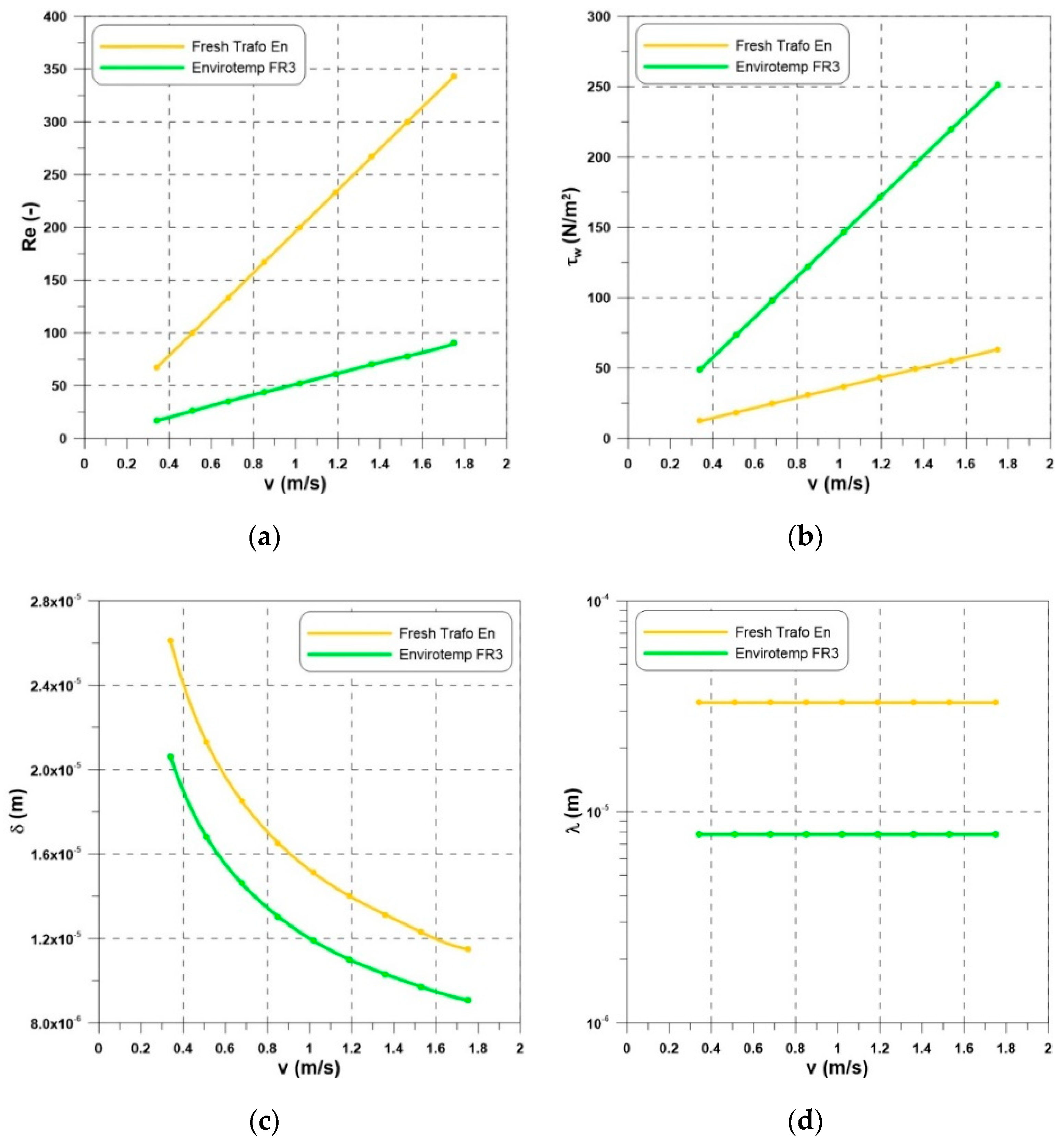
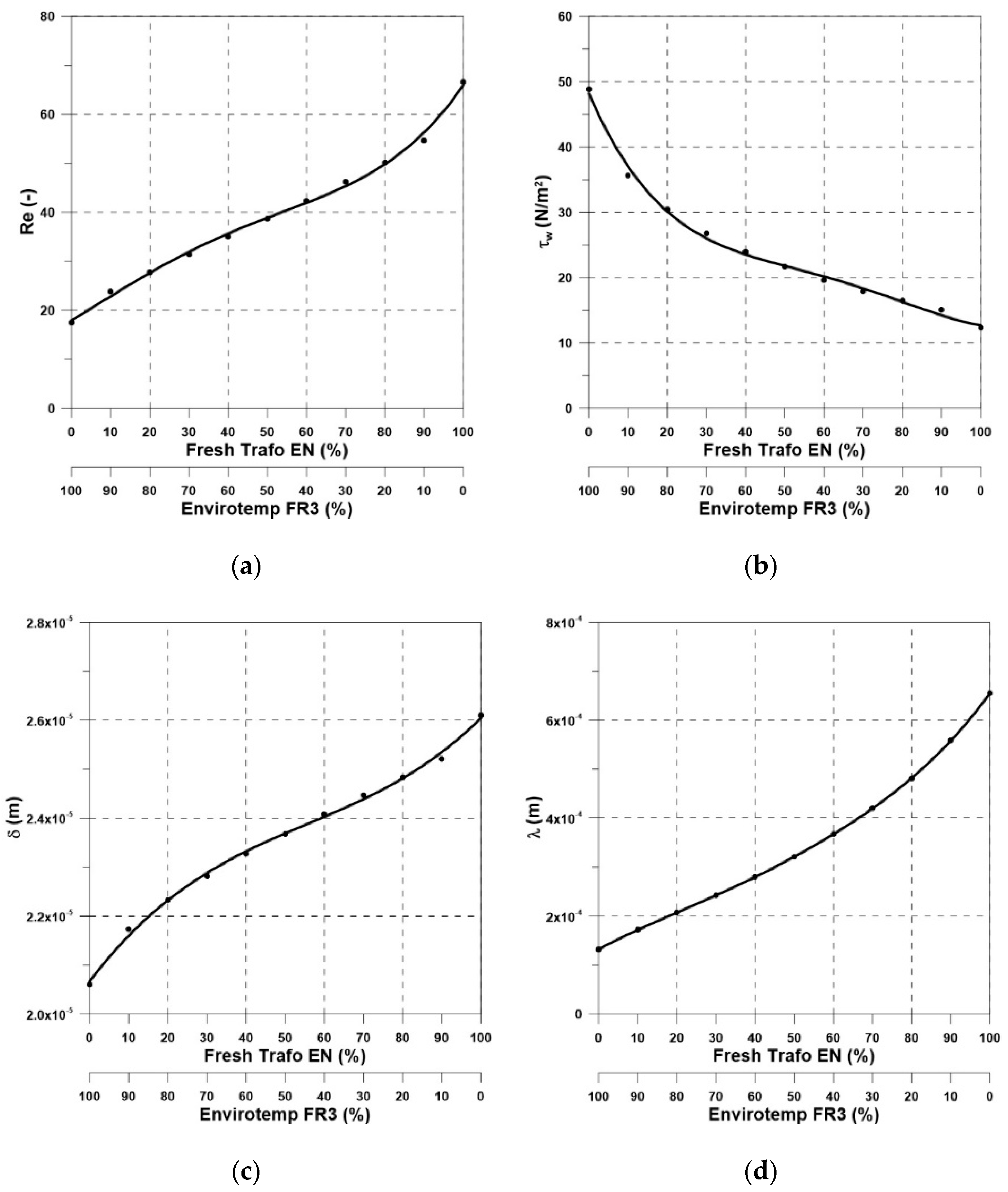
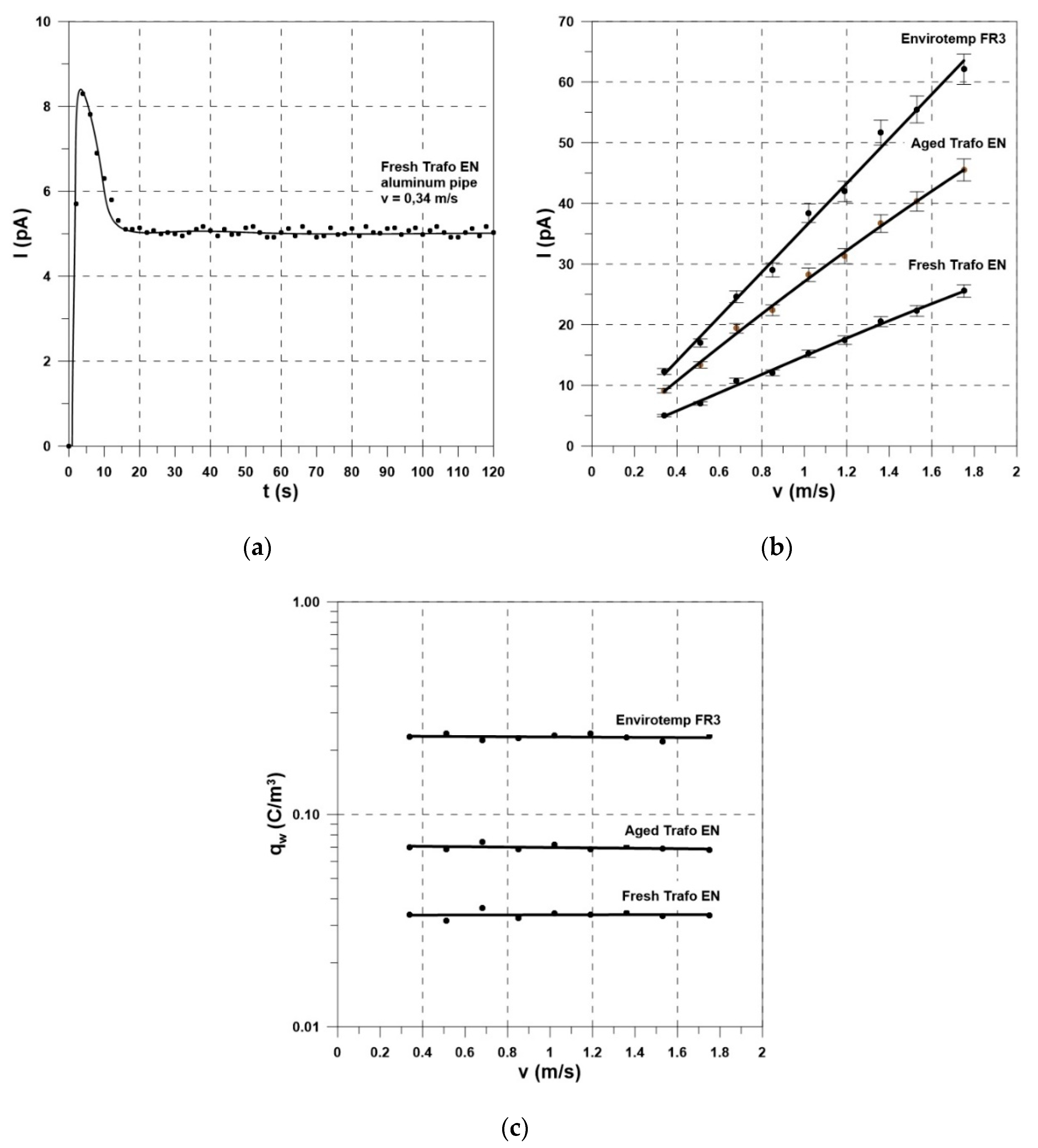
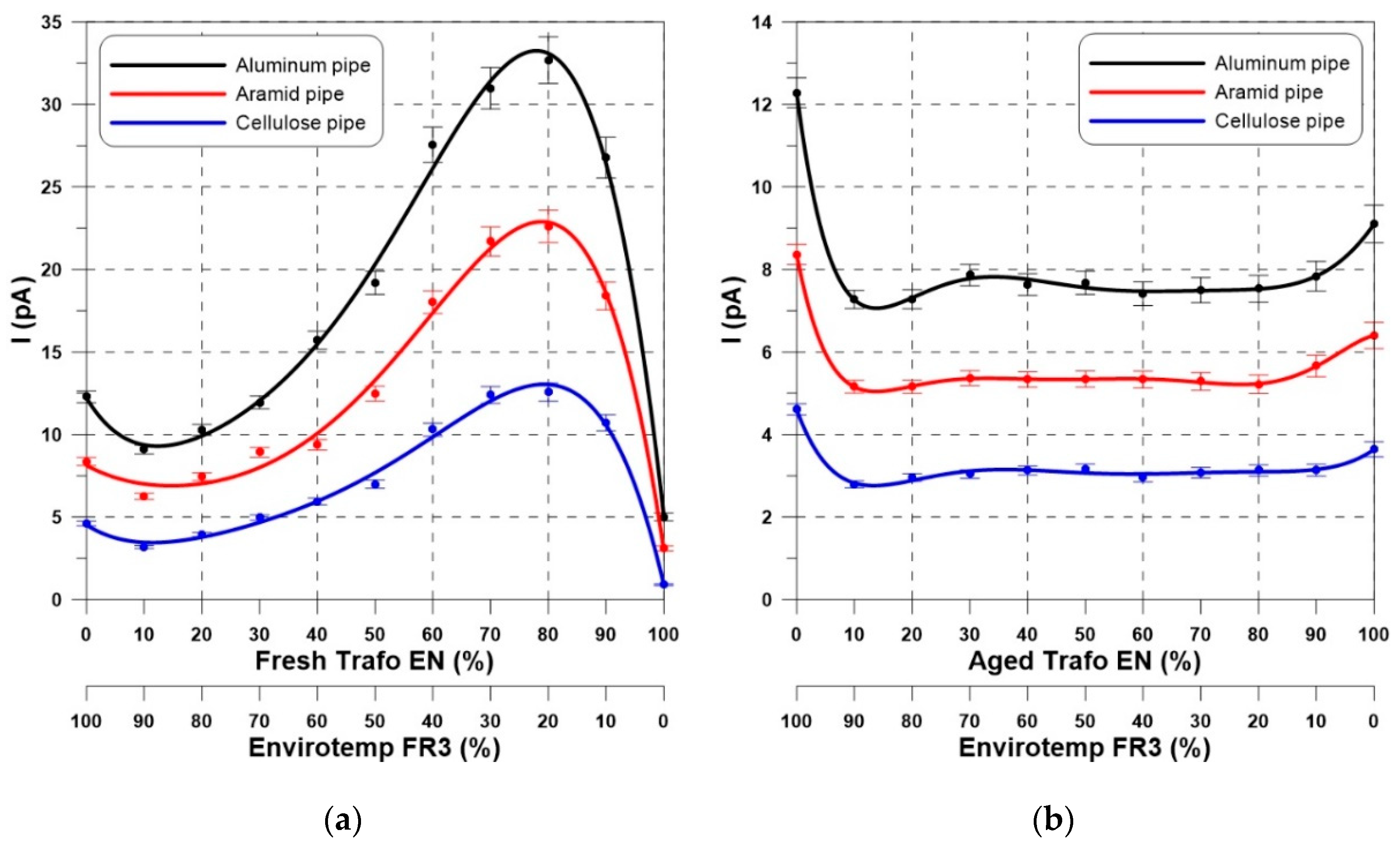
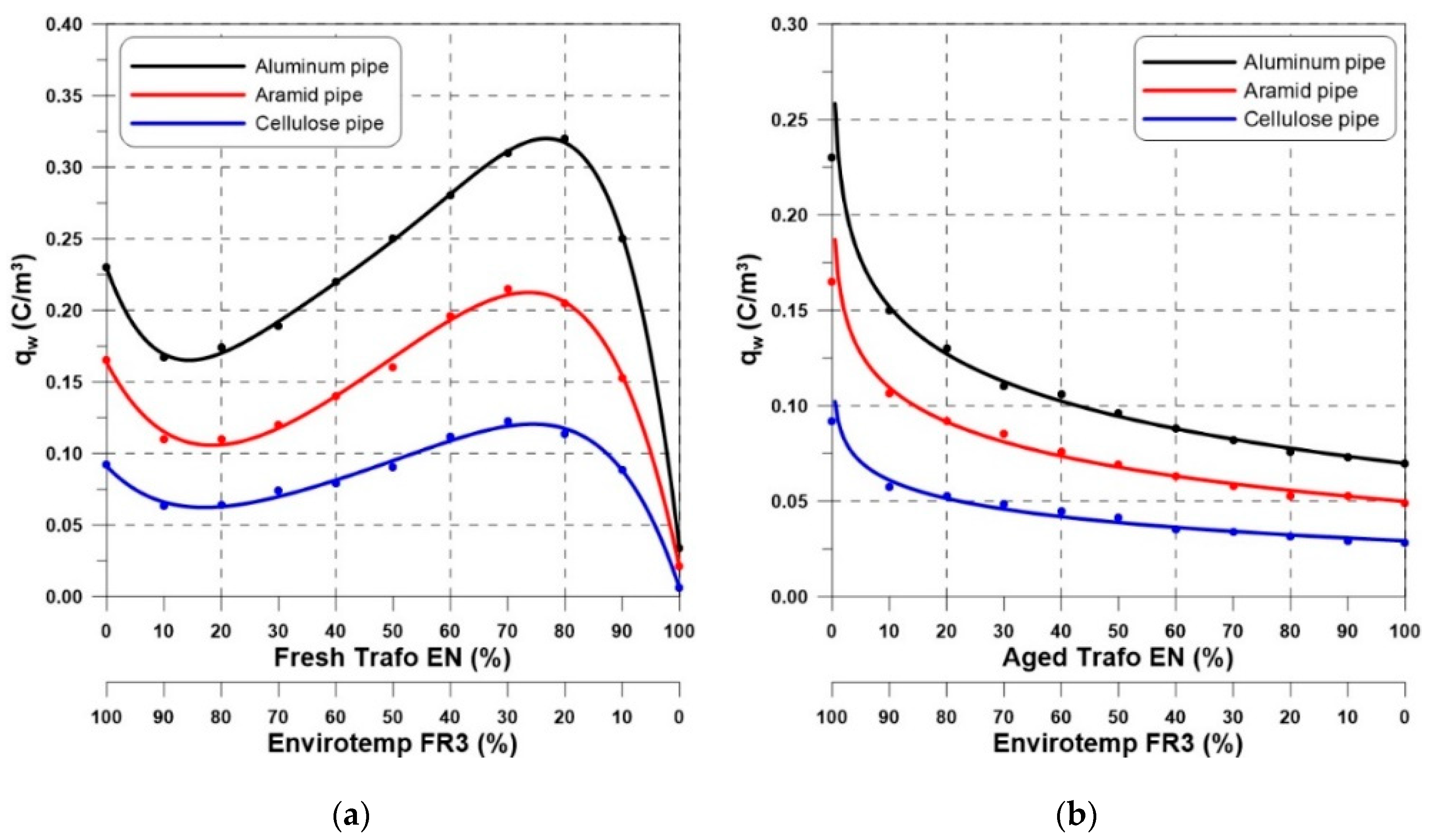
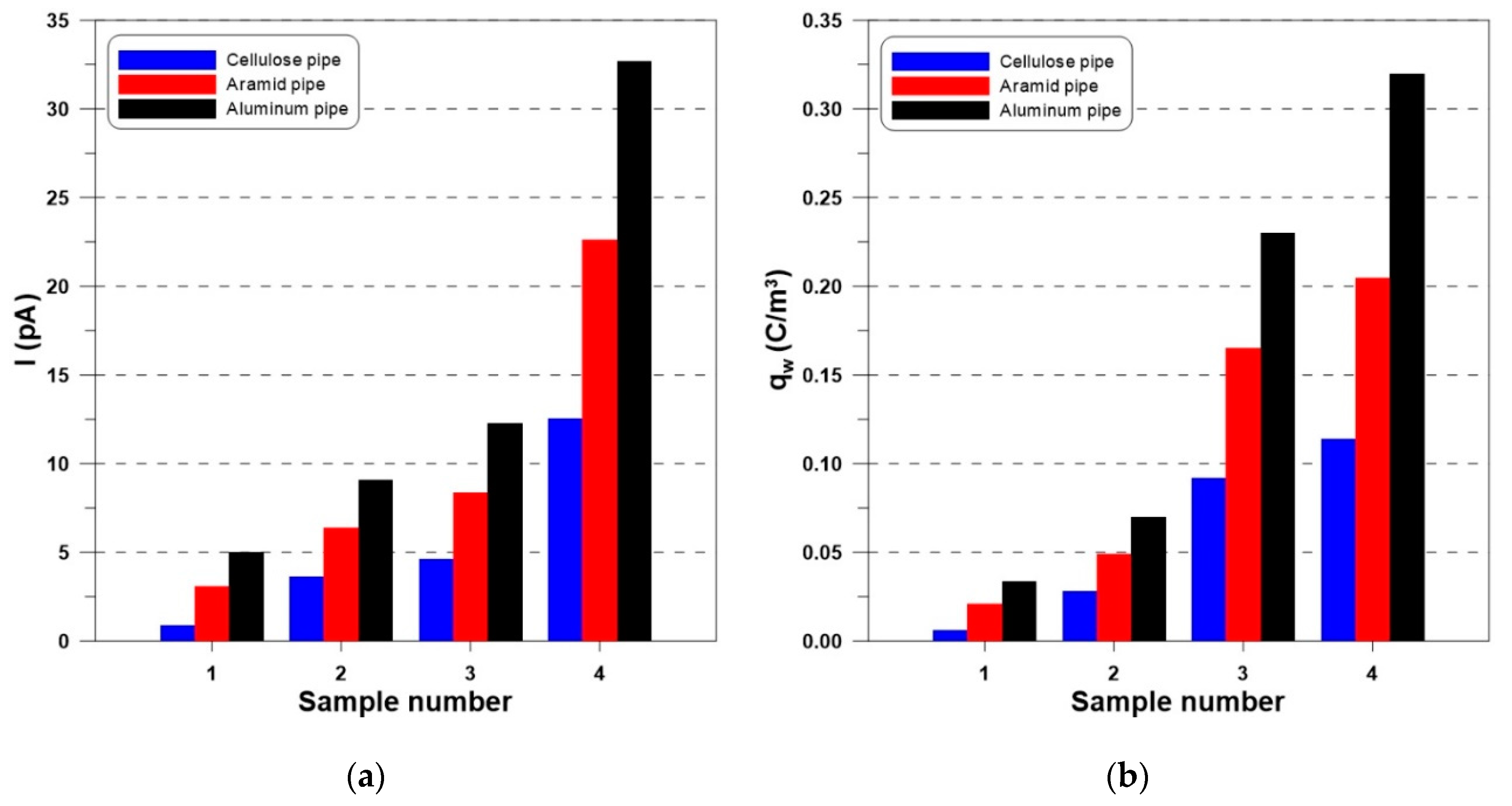
| Mixture Content | ρ (kg/m3) | νk (m2/s) | σ (S/m) | εr (–) | Dm (m2/s) |
|---|---|---|---|---|---|
| NE 100% | 920 | 7.80 × 10−5 | 5.11 × 10−12 | 3.21 | 1.10 × 10−11 |
| 90% NE + 10% MO | 915 | 6.87 × 10−5 | 4.21 × 10−12 | 3.11 | 1.25 × 10−11 |
| 80% NE + 20% MO | 910 | 6.05 × 10−5 | 3.50 × 10−12 | 3.01 | 1.43 × 10−11 |
| 70% NE + 30% MO | 905 | 5.33 × 10−5 | 2.91 × 10−12 | 2.91 | 1.63 × 10−11 |
| 60% NE + 40% MO | 900 | 4.70 × 10−5 | 2.42 × 10−12 | 2.81 | 1.86 × 10−11 |
| 50% NE + 50% MO | 896 | 4.14 × 10−5 | 2.01 × 10−12 | 2.72 | 2.12 × 10−11 |
| 40% NE + 60% MO | 891 | 3.64 × 10−5 | 1.67 × 10−12 | 2.62 | 2.42 × 10−11 |
| 30% NE + 70% MO | 886 | 3.21 × 10−5 | 1.39 × 10−12 | 2.52 | 2.76 × 10−11 |
| 20% NE + 80% MO | 881 | 2.83 × 10−5 | 1.15 × 10−12 | 2.43 | 3.15 × 10−11 |
| 10% NE + 90% MO | 876 | 2.49 × 10−5 | 9.59 × 10−13 | 2.33 | 3.60 × 10−11 |
| MO 100% | 871 | 2.19 × 10−5 | 7.97 × 10−13 | 2.23 | 4.12 × 10−11 |
| Mixture Content | ρ (kg/m3) | νk (m2/s) | σ (S/m) | εr (–) | Dm (m2/s) |
|---|---|---|---|---|---|
| NE 100% | 920 | 7.80 × 10−5 | 5.11 × 10−12 | 3.21 | 1.10 × 10−11 |
| 90% NE + 10% MO | 915 | 6.93 × 10−5 | 5.61 × 10−12 | 3.12 | 1.24 × 10−11 |
| 80% NE + 20% MO | 910 | 6.16 × 10−5 | 6.17 × 10−12 | 3.02 | 1.40 × 10−11 |
| 70% NE + 30% MO | 905 | 5.48 × 10−5 | 6.79 × 10−12 | 2.90 | 1.58 × 10−11 |
| 60% NE + 40% MO | 900 | 4.87 × 10−5 | 7.48 × 10−12 | 2.83 | 1.79 × 10−11 |
| 50% NE + 50% MO | 895 | 4.33 × 10−5 | 8.23 × 10−12 | 2.71 | 2.03 × 10−11 |
| 40% NE + 60% MO | 890 | 3.84 × 10−5 | 9.06 × 10−12 | 2.64 | 2.30 × 10−11 |
| 30% NE + 70% MO | 885 | 3.42 × 10−5 | 9.97 × 10−12 | 2.49 | 2.60 × 10−11 |
| 20% NE + 80% MO | 880 | 3.04 × 10−5 | 1.10 × 10−11 | 2.42 | 2.94 × 10−11 |
| 10% NE + 90% MO | 875 | 2.70 × 10−5 | 1.21 × 10−11 | 2.31 | 3.33 × 10−11 |
| MO 100% | 870 | 2.40 × 10−5 | 1.33 × 10−11 | 2.27 | 3.76 × 10−11 |
© 2020 by the author. Licensee MDPI, Basel, Switzerland. This article is an open access article distributed under the terms and conditions of the Creative Commons Attribution (CC BY) license (http://creativecommons.org/licenses/by/4.0/).
Share and Cite
Zdanowski, M. Electrostatic Charging Tendency Analysis Concerning Retrofilling Power Transformers with Envirotemp FR3 Natural Ester. Energies 2020, 13, 4420. https://doi.org/10.3390/en13174420
Zdanowski M. Electrostatic Charging Tendency Analysis Concerning Retrofilling Power Transformers with Envirotemp FR3 Natural Ester. Energies. 2020; 13(17):4420. https://doi.org/10.3390/en13174420
Chicago/Turabian StyleZdanowski, Maciej. 2020. "Electrostatic Charging Tendency Analysis Concerning Retrofilling Power Transformers with Envirotemp FR3 Natural Ester" Energies 13, no. 17: 4420. https://doi.org/10.3390/en13174420
APA StyleZdanowski, M. (2020). Electrostatic Charging Tendency Analysis Concerning Retrofilling Power Transformers with Envirotemp FR3 Natural Ester. Energies, 13(17), 4420. https://doi.org/10.3390/en13174420





